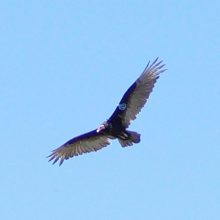Contrasting flapping counterparts, wing shape and migratory habits are unrelated in soaring birds
LINKED PAPER
Wing size but not wing shape is related to migratory behavior in a soaring bird. Graña Grilli, M., Lambertucci, S.A., Therrien J.-F. & Bildstein, K. 2017. Journal of Avian Biology. DOI: 10.1111/jav.01220. VIEW
A considerable amount of literature indicates a significant relationship between migratory habits, wing shape and size of birds. According to earlier studies, migratory birds have more pointed wings and lower wing loading than resident birds (Lockwood et al. 1998, Watanabe 2016). However, most of these studies focused on flapping or gliding birds (Spaar and Bruderer 1997, Lockwood et al. 1998, Milá et al. 2008). What about soaring birds? Their more economic flight mechanism (with a high dependence on body size) and their requirements for particular weather conditions for flying, may modify that relationship.
We compared wing morphology and size of five populations of Turkey Vultures, Cathartes aura, an obligate soaring bird, from different parts of their distribution. Among these, three populations were completely migratory, one was partially migratory and one population was resident. We studied wing size through the wing loading of each bird, and wing shape through aspect ratio, and related these measurements to the migratory parameters for each population. All the movement data used are freely available at Movebank.org (study ID 217784323: DOI10.5441/001/1.37r2b884; Bildstein et al. 2016).

Our analysis showed that wing loading was lower in birds that migrated farther, longer, faster and higher (relative to sea level). However, aspect ratio did not show differences among populations of Turkey Vultures with different migratory habits.
 Figure 2 Map showing the location and migratory paths of the Turkey Vulture populations studied
Figure 2 Map showing the location and migratory paths of the Turkey Vulture populations studied
In contrast to previous work (mostly focused on species with flapping flight), which found that migratory birds have wings with lower aspect ratio (i.e. more pointed wings) than resident ones, our findings did not find this same pattern in a soaring species. Furthermore, the fact that we did find differences in wing loading related to migratory habits suggests that in soaring birds wing size may be more important for flight optimization than in flapping birds.
It can be inferred that according to each flight mechanism, there may be differences in morphological requirements related to energetic optimization. In this sense, in soaring birds, the reduced cost of flight may be only further reduced through changes in the relative size of the wings. It is also possible that other selective pressures apart from migration (like foraging behaviour), have an important role in wing morphology of Turkey Vultures. The ability to exploit weak thermals would allow Turkey Vultures to search for food in large areas and for longer during the day. However, Turkey Vultures have lower wing loading than related species with the same feeding habits, but none of them are migrants (D’Elia and Haig 2013, Shepard and Lambertucci 2013). Therefore, it can be hypothesized that reduction in wing loading in Turkey Vultures may confer important advantages for migration, such as allowing the birds to ascend higher in thermals and to lose altitude more slowly during the gliding phase of soaring, thereby increasing the speed and distance traveled during migration.
References
Bildstein, K.L., Barber, D., Bechard, M.J. & Graña Grilli, M. 2016. Data from: Wing size but not wing shape is related to migratory behavior in a soaring bird. – Movebank Data Repository, DOI: 10.5441/001/1.37r2b884. VIEW
D’Elia, J. & Haig, S.M. 2013. California condors in the Pacific Northwest. Oregon State Univ. Press. VIEW
Lockwood, R., Swaddle, J.P. & Rayner, J.M. 1998. Avian wingtip shape reconsidered: wingtip shape indices and morphological adaptations to migration. J. Avian Biol. 29: 273–292. VIEW
Milá, B., Wayne, R.K. & Smith, T.B. 2008. Ecomorphology of migratory and sedentary populations of the yellow-rumped warbler (Dendroica coronata). Condor 110: 335–344. VIEW
Shepard, E.L. & Lambertucci, S.A. 2013. From daily movements to population distributions: weather affects competitive ability in a guild of soaring birds. J. R. Soc. Interface 10: 6–12. VIEW
Spaar, R. & Bruderer, B. 1997. Migration by flapping or soaring: flight strategies of Marsh, Montagu’s and pallid harriers in southern Israel. Condor 99: 458–469. VIEW
Watanabe, Y.Y. 2016. Flight mode affects allometry of migration range in birds. Ecol. Lett. 19: 907–914. VIEW
Image credit
Featured image: Turkey Vulture, Cathartes aura © Facundo Barbar
If you want to write about your research in #theBOUblog, then please see here.





